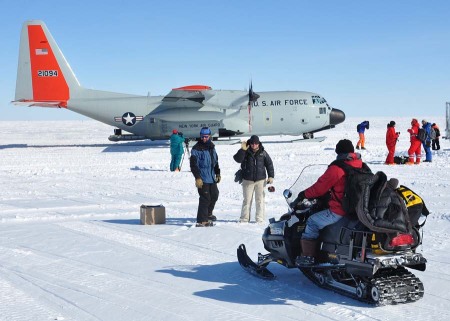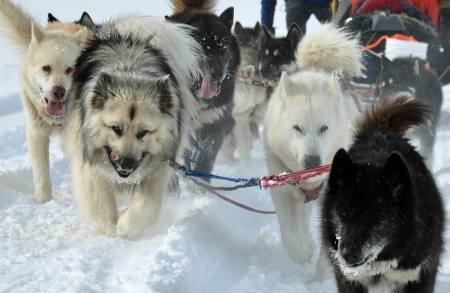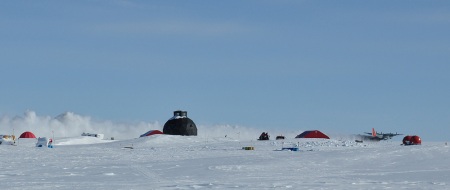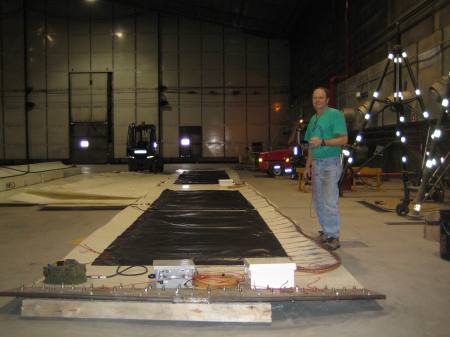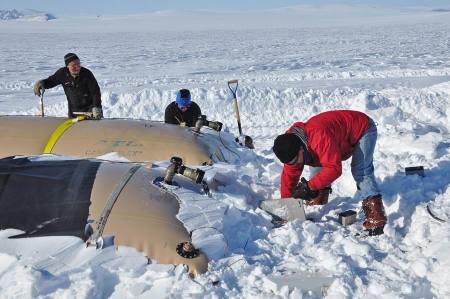
Pictured outside the University of Alaska Museum of the North, the 2010 PolarTREC teachers and alumni (left to right), Jeff Peneston (Icebreaker Oden-2008), Jim Pottinger, Josh Dugat, Cheryl Forster, Chantelle Rose, Mike Lampert, Keri Rodgers, Karl Horeis, Tina Sander, Michele Cross (McMurdo Station-2009), Craig Beals (Summit-2008), Anne Marie Wotkyns, Bill Schmoker, Lesley Urasky, and Claude Larson. Unless otherwise noted, photos by Kristin Timm, Arctic Consortium of the United States, for PolarTREC
It’s that time of year again! Janet Warburton and Kristin Timm of the Arctic Research Consortium of the U.S. (ARCUS) are preparing K-12 educators from across the United States for upcoming field experiences in the Arctic and Antarctic. Twelve teachers who spent a week in Fairbanks, Alaska, in April for the PolarTREC Orientation and ShareFair, an intensive week-long introduction to the professional development experience.
PolarTREC (Teachers and Researchers Exploring and Collaborating), now in its fourth year (and with a recent NSF funding renewal through December of 2013), is a professional development program for K-12 educators focused on improving science, technology, engineering, and mathematics (STEM) education.
Through teacher-researcher collaborations and hands-on field experiences, teachers become an essential bridge between cutting-edge polar science and the public. By working closely with selected PolarTREC research teams through application review and teacher interviews, researchers and teachers are matched across a wide range of scientific disciplines to ensure that teachers’ interests are aligned with science project goals. After much training and preparation, teachers spend 2-6 weeks in the field with their research team. During their time out, teachers share their experiences through webinars, multimedia journals, and bulletin boards on PolarTREC’s interactive Web site.

Ann Harding and Rachael Orben prepare to take blood samples of captured birds, Kap Hoegh, Greenland. Photo by Mary Anne Pella-Donnelly (PolarTREC 2007), Courtesy of ARCUS
PolarTREC’s mission includes increasing teachers’ knowledge of polar science along with their ability to teach pertinent science concepts. The program allows teachers to improve their instruction by participating in a new and exciting research experience, exposing them to new ideas and incorporating technology both in and out of the field. Teachers also develop new curricula, which is disseminated through the PolarTREC site. PolarTREC wants their teachers to inspire students to become more aware of the Polar Regions and explore opportunities to further their education and explore occupations in STEM areas.
During the PolarTREC orientation teachers learned background science content, how to communicate successfully from the field, and how to develop polar science education and outreach plans and ideas. Hands-on breakout sessions include digital photography, journaling methods, using educational technologies, and bringing science into the classroom. PolarTREC teacher and research alumni as well as representatives from CH2M HILL Polar Services (CPS) were also on hand in-person and virtually to share experiences and address teacher questions and expectations.

Following a presentation from Roy Stehle of SRI International (part of CPS), teacher Anne Marie Wotkyns practiced using the satellite phone by calling home from the Westmark Hotel parking lot. Wotkyns will work with scientists on the Icebreaker Oden in November.

PolarTREC Alumni, Craig Beals (Summit-2008), offers advice to the new group of teachers. Three PolarTREC alumni were on hand during orientation to share information and lessons learned about their field experience, maintaining collaborations with the research team, and taking PolarTREC back to the classroom.

Matt Irinaga of Polar Field Services (part of CPS) explains the science of cold weather dressing: layer, layer, layer! Photo: Robbie Score
We’ll be checking in on PolarTREC teachers during their field experiences – stay tuned!



 Posted by writer walker
Posted by writer walker 